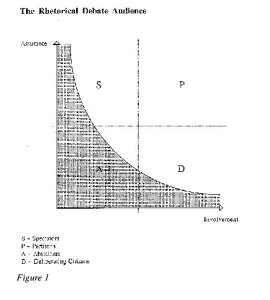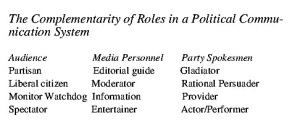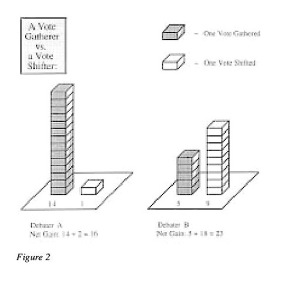ISSA Proceedings 1998 – The Rhetorical Audience In Public Debate And The Strategies Of Vote-Gathering And Vote-Shifting
No comments yet In the pragma-dialectical approach to argumentation, as represented by van Eemeren & Grootendorst (e.g., 1992) or Walton (1989, 1992, 1995), critical discussion provides the normative model for rational argument. But do the norms for critical discussion also apply to political debate? As rhetoricians, we insist that critical discussion and political debate are different genres with different norms. Critical discussion is dialogic, debate is trialogic (Dieckmann 1981, Klein 1991). The arguers in the discussion address each other with the cooperative goal of resolving the dispute; debaters do not argue in order to persuade each other, but to win the adherence of a third party: the audience (Jørgensen, in press).
In the pragma-dialectical approach to argumentation, as represented by van Eemeren & Grootendorst (e.g., 1992) or Walton (1989, 1992, 1995), critical discussion provides the normative model for rational argument. But do the norms for critical discussion also apply to political debate? As rhetoricians, we insist that critical discussion and political debate are different genres with different norms. Critical discussion is dialogic, debate is trialogic (Dieckmann 1981, Klein 1991). The arguers in the discussion address each other with the cooperative goal of resolving the dispute; debaters do not argue in order to persuade each other, but to win the adherence of a third party: the audience (Jørgensen, in press).
Because of its trialogic nature, a debate must answer the needs of the audience. This means that a debate should be evaluated in relation to the functions it fulfils. This does not mean that our approach is oriented toward uses and gratifications in the traditional sense. We are interested not only in the functions of debate, but also in the specific features of debates that serve these functions; and our approach is normative.
We shall concentrate on issue-oriented debates, such as the Irish debate over the Ulster peace plan, or the Danish debate over the Amsterdam treaty. What we have to say about the rhetorical audience and the quality of public debate has particular reference to how debate is conducted on TV.
Opinion polls will tell us that the audience of such debates consists of three groups: those in favour, those against, and the undecided. Commentators typically refer to the undecided as those who have not made up their minds yet, implying that all the others have indeed made their minds up. Accordingly, it is assumed that the outcome depends on the remaining undecided voters.
But this is misleading. Both among those in favour and among those against, there are many who have not made their minds up, and who may well change sides – under the influence of events or arguments. To document this, we may cite a poll in the French daily Libération shortly before the referendum in France on the Maastricht treaty in 1992. Here – interestingly – voters were asked whether they might change sides on the issue. No less than 37 % of those who intended to vote yes admitted they might also vote no, and conversely for 34 % of those who said they intended to vote no. It is probably true that especially in matters concerning the European Union many voters are in two minds; they feel that there are arguments on both sides of the issue, and they are constantly weighing them against each other.
What this means is that on any issue, the audience represents a spectrum of opinion, with unmoveable partisans at both ends, and with a fair number of voters near the middle of the road who lean to one side but who may be shifted. But debaters and TV programmers tend to make the undecided their primary target because they falsely believe that the static and simplistic Yes-Undecided-No model says all one needs to know about the debate audience. They forget the lesson of the Danish referendum which rejected Maastricht because many voters changed sides at a late stage, even at the polling station.
To understand how some voters can thus be in two minds, we shall propose a model of the debate audience (inspired by Tonsgaard 1992). This, in turn, will allow us to distinguish between the different functions of debate for the public audience.
In this figure, the undecided are represented by the grey area beneath the curve. The white area represents the decided voters, i.e. those who say that they are going to vote yes or no, respectively. Those near the curve are the hesitant voters. The point is that there are two variables which may explain why voters hesitate. These are represented by the two axes.
The x axis represents involvement in the issue, that is, how important the voter perceives the issue to be. The y axis represents the voter’s feeling of assurance on the issue. Those high in both assurance and involvement belong in the area marked “P” (for partisans). What they will want from debates is mainly reinforcement of their existing views. Those low in both assurance and involvement will belong in the area marked “A” (for abstainers, because these people will probably end up not voting at all). But it is also possible to have a quite fixed and assured view of the issue, either for it or against it, and yet feel that it is all quite distant and uninteresting.
These voters – high in assurance but low in involvement – will be in the “S” area (for spectators). They will probably feel little need for guidance because they know what they think – but more of a need for entertainment, and some need for reinforcement. Finally, many voters – certainly in Denmark – see the European issue as highly important, but also as complex and baffling; and that is why they are hesitant. These voters – who are high in involvement but low in assurance – belong in the “D” area (for deliberating citizens). Although they lean to one side, they feel they need to know and understand more, because they are still in two minds; hence they want the ongoing debate to give them guidance for the decision they confront.
This segmentation of the debate audience reflects the analysis of three of the audience roles defined by Gurevitch & Blumler (1977). Their account also includes roles for “media personnel” and “party spokesmen”, as seen in the following table.
In our context, we may disregard the “monitor” role, since we regard it as less relevant for members of a debate audience, and more applicable to, for example, political scientists and commentators. What the voter seeks when he appears in the partisan role is precisely “reinforcement of his existing beliefs”; as a spectator, he seeks “excitement and other affective satisfactions”; as a deliberating citizen – or, as Gurevitch and Blumler have it, “liberal citizen” – the voter seeks “guidance in deciding how to vote” (1977: 276). Our model of the debate audience explains the notion of audience roles and their underlying parameters. The model also implies that there are two basically different ways that a debater can try to increase adherence to his view, dependent on which segment of the our model he mainly appeals to.
1. The debater can prefer to appeal mainly to those who are rather high in assurance, but low in involvement. These people will basically tend to choose the spectator role. Since they are rather assured about their views, the debater must concentrate on those voters in this group who lean to his side already. Those who plan to vote for the side anyway will merely have their enthusiasm boosted. Those who might not have voted may be stimulated to come out and do so. Thus the way this strategy may gain votes is by mobilizing some of the undecided vote. We call this strategy vote-gathering.
2. The other general strategy is to appeal to those voters who lean to the other side but who may be won over. These people are high in involvement, that is, they think the issue is important; but they are low in assurance. Typically, they are deliberating citizens who acknowledge that there are two sides to the issue and that their decision should be based on the weight of the arguments. As we have pointed out, there are often a substantial number of such voters on both sides. We call this strategy vote-shifting.
The distinction between vote-gathering and vote-shifting was one of the perspectives we became aware of in a study of televised public policy debates in Denmark (Jørgensen, Kock, and Rørbech 1994; 1998). In these debates we found voting patterns suggesting that some debaters are particularly good at vote-gathering, others at vote-shifting. For example, in one debate, in front of a hundred representative jurors, one debater gathered no less than 14 votes from the undecided group, but she shifted only one from the opposite side; the opponent gathered just 5, but shifted 9. This is shown in figure 2, where the grey columns show votes gathered and the white ones show votes shifted.
If it is true that some debaters excel at gathering votes, while others are good at shifting votes, then we may ask: What are the essential features of the two types of argumentative strategy that have these distinct effects? Observations from our empirical study have led us to the following hypothesis, which is also consistent with much rhetorical theory. We believe the typical vote-gathering debater will tend to broaden the front between the two opposite sides, while the typical vote-shifter will tend to narrow it.
The typical vote-gatherer will tend to claim fundamental, black-and-white differences and introduce a series of further points of contention that will broaden the front between the two sides. He will claim a fundamental ideological opposition between the two sides; he will impute a series of further claims and positions to the opponent that have not been mentioned by the opponent himself; he will see the opponent’s proposal as “the thin end of the wedge,” as part of a large campaign, or even of a conspiracy; he may attack his opponent’s motives, he may bring in matters that cast doubt on the opponent’s intelligence, ethics, or good will; he will typically attack the weakest arguments made by the opponent, trying to make them out as ridiculous, or as self-contradicting. Front-broadening arguers generally spend much energy on refutations of arguments made by the opponent, and on counter-refutations of refutations, and so on ad infinitum. In all this, the issue at hand will often disappear in a confusing verbal duel. As audience, we may find ourselves turning our heads back from right to left and back again, as if watching a tennis match. Refutation and counterrefutation are what we would call secondary argumentation, as distinct from primary arguments. These are the grounds offered by the debaters in direct support of their standpoints – i.e., the main merits of their own proposal, or the drawbacks of the opponent’s. Throughout, the front-broadening debater introduces topics of disagreement that are not necessary to elucidate the disagreement at hand.
The vote-shifter, on the other hand, will argue so as to narrow the front, concentrating on the specific issue that separates the opponents. He will, for example, concede that the opponent has certain weighty arguments, but he will then try to show that his own arguments are weightier. He will typically narrow or demarcate his claim, stating, for example, that he does not advocate a federal superstate in Europe, but that he does strongly advocate a union of nation states for certain reasons. He will concentrate on his own primary grounds for his claim; for example, he will concentrate on the main reasons why he thinks the Amsterdam treaty is a good idea (or, if he is against it, a bad idea), and he will spend less energy refuting the opponent’s grounds, or counter-refuting the opponent’s refutations. We might add that this emphasis on primary grounds, rather than on refutation, is one point where our normative criteria, based on audience needs, differ from the norms for critical discussion.
Furthermore, the front-narrowing debater will treat his opponent with politeness and respect and avoid face-threatening attacks on his person, ethics, and competence. In all these manouevers, the debater seeks to find and preserve whatever common ground there is between the opposite sides, narrowing the front to what is absolutely necessary.
In terms of the traditional rhetorical appeals, the vote-gatherer will rely heavily on pathos and will, for instance, use Atkinson’s “claptraps” in abundance (Atkinson 1984). As is well known, Atkinson described two principal types of claptrap: the contrast, which is clearly a front-broadening feature, and the list of three, a schematic figure of great dynamism, known from ritual and folk literature. Both are clearly front-broadening devices to enhance the feeling of “us” against “them”. The use of these devices will help the vote-gatherer boost the partisan’s spirit and give the spectators a good show. The vote-shifter, in contrast, relies mainly on logos appeals and avoids devices that may appear cheap or facile. As for ethos, the vote-gatherer will tend to impress by being either sparkling or passionate, while the vote-shifter tends to be a more academic type, perhaps slightly stiff and dry, but serious and knowledgeable.
All in all, it is clear that of these two types of argumentation, the vote-gatering, front-broadening type is by far the more “telegenic”, as media people say. This brings us to the role of TV in public debate.
Now, our point in contrasting the two types is of course not that debaters should become pure vote-shifters and never try to be vote-gatherers. Surely good debaters are those who manage to combine elements from both strategies. Nor do we claim that vote-gathering is bad rhetoric at all times. Many situations call especially for vote-gathering; but issue-oriented debate does not. The problem is that many forces in modern TV-mediated democracy unite in suppressing the kind of political argument that aspires, and inspires, to vote-shifting debate. TV debates, when best, are both entertaining and informative. But at times there is a conflict. What works well as TV is often front-broadening features that leave little opportunity for shifting rhetoric to unfold; what boosts and entertains partisans and spectators often alienates the deliberating citizen looking for guidance. In consequence, the media furthers the transformation of citizens to a body of, in Jamieson’s words, viewers “observing the ‘sport’ of politics” (Jamieson 1992: 191).
Front-broadening, vote-gathering TV debates thus appear to be the modern version of sophistic rhetoric. Sophistic debate is basically a type of combat, with debaters in the role of gladiators, in Gurevitch and Blumler’s term. Such a debate may serve a mobilizing purpose for us if we are partisans of the gladiators, but that role easily slips into the purely spectatorial role where debaters are as much actors, at whose performance we either applaud or hiss. This audience role echoes Aristotle’s description of the auditor as “spectator” in epideictic speech, vs. the role as “judge” in political and forensic speech. According to Aristotle, the spectator is concerned with the ability of the speaker (Rhetoric III, 1358b). The spectator, as George Kennedy explains, “is not called upon to take a specific action, in the way that an assemblyman or juryman is called upon to vote”; the whole event becomes “an oratorical contest” (p. 48, note 77) – which is also how commentators see it when they discuss which politician “did best” in a TV debate. Thus the deliberative function of debate is suppressed by the simplistic question, so dear to the media, of “who loses and who wins”. While spectators see such debates as a sports event, its effect on partisans may be described in the words of Perelman & Olbrechts-Tyteca on the epideictic genre: “the argumentation in epidictic discourse sets out to increase the intensity of adherence to certain values” (1969: 51).
What is problematic with the spectator and partisan roles according to the deliberative ideal is that they tend to turn the audience into mere bystanders rather than participants in the political process. Only as deliberating citizens do we become a genuine rhetorical audience in Bitzer’s sense of the word – an audience of decision- makers, “capable of being influenced by discourse and of being mediators of change” (Bitzer 1968, 1992: 7).
We may compare our view here with Walton’s pragmatic approach: Walton is critical of debaters who have fixed positions, so that there is no “genuine chance of either side persuading the other” (1992: 157). However, Walton ignores the trialogic nature of debate, which makes it quite acceptable for debaters to be unwilling to be persuaded by each other. What threatens the legitimacy of debate is when it is conducted in such a way that there is no chance of anyone in the audience shifting to the other side.
To sum up, what we advocate in issue-oriented debate is that vote-shifting argumentation be allowed to unfold – i.e., argumentation strongly characterized by the features we have called front-narrowing. The purpose of course is not the shifting of voters as such. We call for more vote-shifting argumentation for normative reasons.We propose that if debaters argue with the shiftable voters on the opposite side as their primary addressees, this would stimulate them to produce convincing argumentation, i.e., arguments that those on both sides of the boundary who recognise the force of argument would consider weighty – whether they are persuaded by them or not. Thus, the deliberative goal would not be lost, namely that of providing citizens with the best arguments on both sides, to be weighed against each other, in order to reach a decision. The net result at the polling station would perhaps be pretty much the same. But decisions would be made on a firmer basis, and debates would better serve the purpose of informed political argument. They would not degenerate into mere sports events for spectatators or peptalk for partisans, and citizens might remain active participants in the political process.
REFERENCES
Aristotle. On Rhetoric: A Theory of Civic Discourse. Ed. George Kennedy (1991). New York: Oxford University Press.
Atkinson, Max. (1984). Our Masters’ Voices: The Language and Body Language of Politics. London: Methuen.
Bitzer, Lloyd F. (1968). The Rhetorical Situation. Philosophy and Rhetoric 1,1-14 (Reprint Supplementary Issue 1992).
Dieckmann, Walther (1981). Politische Sprache, politische Kommunikation: Vorträge, Aufsätze, Entwürfe. Heidelberg: Carl Winter Universitätsverlag.
Eemeren, Frans H. van & Rob Grootendorst (1992). Argumentation, Communication, and Fallacies. A Pragma-Dialectical Perspective. Hillsdale, New Jersey:: LEA.
Gurevitch, Michael and Jay G. Blumler (1977). Linkages between the Mass Media and Politics: a model for the analysis of political communication systems. James Curran, Michael Gurevitch, and Janet Woollacott (eds.) Mass Communication and Society (pp. 270-290) London: Edward Arnold.
Jamieson, Kathleen Hall (1992). Dirty politics: Deception, Distraction, and Democracy. New York: Oxford University Press.
Jørgensen, Charlotte (in press). Public Debate: An Act of Hostility? Argumentation.
Jørgensen, Charlotte, Christian Kock, & Lone Rørbech (1994). Retorik der flytter stemmer: Hvordan man overbeviser i offentlig debat. Copenhagen: Gyldendal.
Jørgensen, Charlotte, Christian Kock, & Lone Rørbech (1998). Rhetoric That Shifts Votes: An Exploratory Study of Persuasion in Issue-Oriented Public Debates. Political Communication 15, 283-299.
Klein, Josef (1991). Zur Rhetorik politischer Fernsehdiskussionen.
Ueding, G. (ed.). Rhetorik zwischen den Wissenschaften. Geschichte, System, Praxis als Probleme des “Historischen Wörterbuchs der Rhetorik (pp. 353-362). Tübingen: Max Niemeyer.
Perelman, Chaim, & Olbrechts-Tyteca, Lucie. (1969). The New Rhetoric: A Treatise on Argumentation. Notre Dame: Notre Dame University Press.
Tonsgaard, Ole. (1992). A Theoretical Model of Referendum Behaviour.
Gundelach, Peter, & Karen Siune (eds.). From Voters to Participants. Esaays in Honour of Ole Borre. Århus: Politica.
Walton, Douglas N. (1989). Informal Logic: A Handbook for Critical Argumentation. Cambridge: Cambridge University Press.
Walton, Douglas N. (1992). Plausible Argument in Everyday Conversation. Albany: State University of New York Press.
Walton, Douglas N. (1995). A Pragmatic Theory of Fallacy. Tuscaloosa: The University of Alabama Press.
You May Also Like
Comments
Leave a Reply








